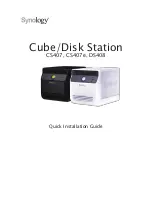
B -4
network address
Every
on a network has one or more addresses associated with it.
Every node has what is called a “hardware address” that is unique across
every network. If you know a node’s hardware address, you should be
able to identify the exact piece of equipment that goes with it. Hardware
addresses are generally set up by the company that manufactured the
equipment and should never change. The hardware address is usually
specified as a list of six hexadecimal numbers separated by dashes, such
as “ae-34-2c-1d-69-f1.” The hardware address for your RapidPrint 500 is
shown on a label on the rear of the unit.
In the case of
networks, each node also has a software or “IP”
address that is configurable by the managers of the nodes.
The software address is usually specified as four decimal numbers sepa-
rated by periods (for example, “197.49.155.247”). In this case, each num-
ber must be between zero and 255, and each corresponds to a different
network or sub-network. Depending on how many other nodes and net-
works a node can “see” on its network, addresses are either assigned to
nodes (in the case of large, cross-country networks) or chosen randomly
(for small networks that do not connect to the outside world). Each soft-
ware address should be unique across all the networks it can access.
node
A node is any intelligent device connected to the network. This includes
terminal servers, host computers, and any other devices that are directly
connected to the network. A node can be thought of as any device that
has a “hardware address” (see
). A “service node” is a
node on the network that provides a service other users can connect to,
for example, a printer. A terminal server that allows only local logins, on
the other hand, is not a service node, as it does not allow remote network
users to connect to it.
PostScript
A printer/display protocol developed by Adobe Corp. PostScript is an
actual printing and programming language to display text and graphics.
Unlike line/ASCII printers, which print character input verbatim, Post-
Script printers accept an entire PostScript page, and then interpret and
print it. The programming aspects of PostScript can be used to define
shapes and routines that will be used on successive pages, change fonts
and text orientation, and print fine bitmap images within blocks of text.
protocol
Any standard method of communicating over a network. There are proto-
cols for placing actual bits onto the network cable; other protocols are lay-
ered on top from there.
is a protocol for network access, while both
TCP
and IP are also protocols (TCP runs on top of the IP layer/protocol).
proxy service
A proxy
is created when the RapidPrint 500 is configured to offer
a Telnet host as a LAT service. When the users connect, the RapidPrint
500 translates between the LAT and Telnet sessions. When the user logs
out of the remote Telnet host, he is also disconnected from the RapidPrint
500.
RARP
RARP is a protocol that allows a node to broadcast a message asking for
an IP address given its hardware address. If a RARP server has been con-
figured to reply to this node, it will tell the node what its IP address
should be. Note that RARP provides less information than BOOTP, but is
more widely implemented.
Summary of Contents for RapidPrint 500
Page 8: ...viii...
Page 10: ......
Page 16: ......
Page 26: ......
Page 28: ......
Page 38: ......
Page 40: ......
Page 54: ......
Page 58: ......
Page 60: ......
Page 66: ......
Page 72: ......
Page 78: ......
Page 94: ......
Page 96: ......
Page 176: ......
Page 178: ...Digital Problem Report Procedure Technical Support A 2...
Page 186: ......











































